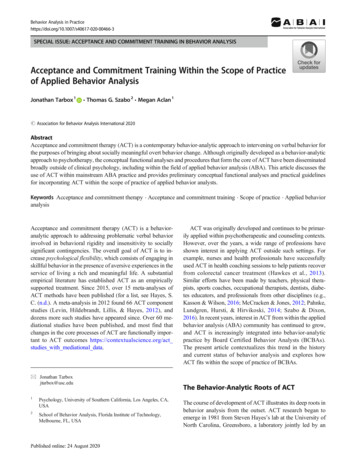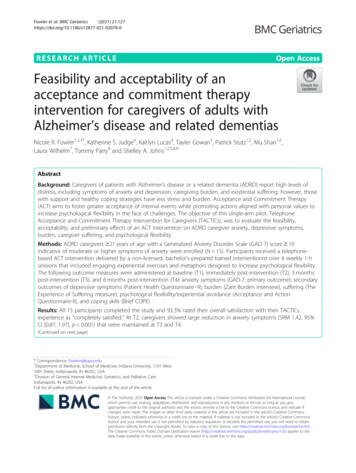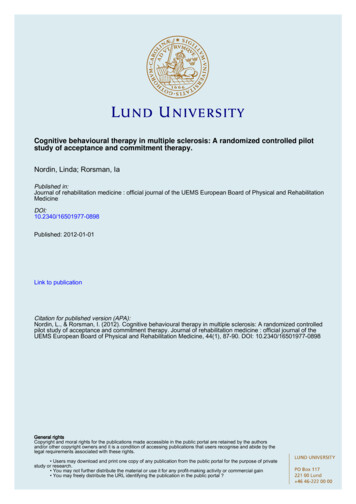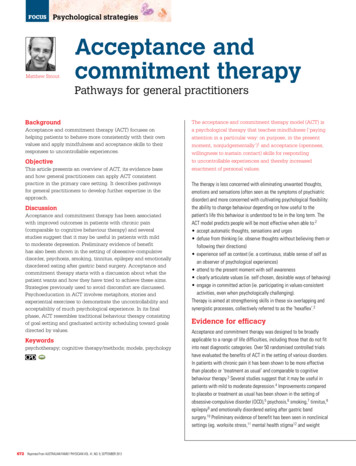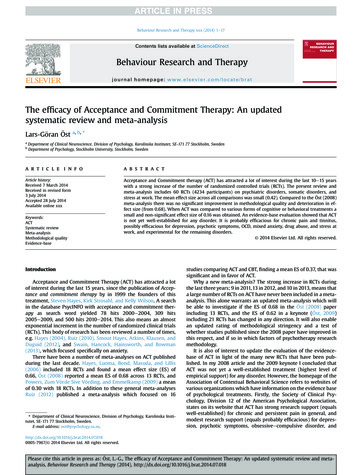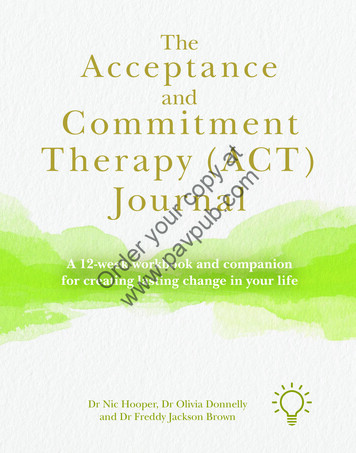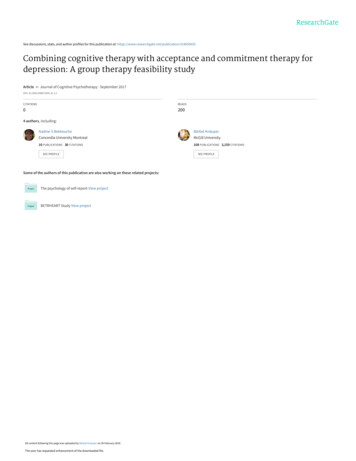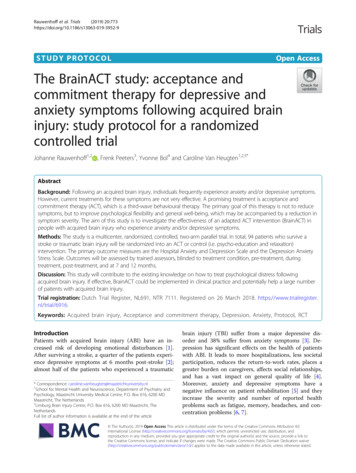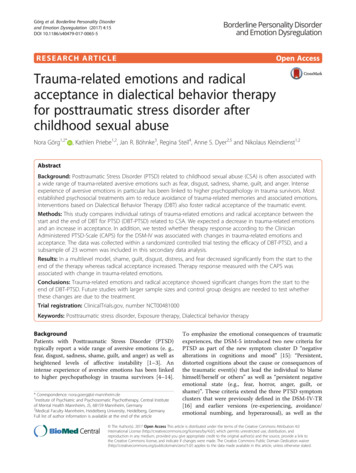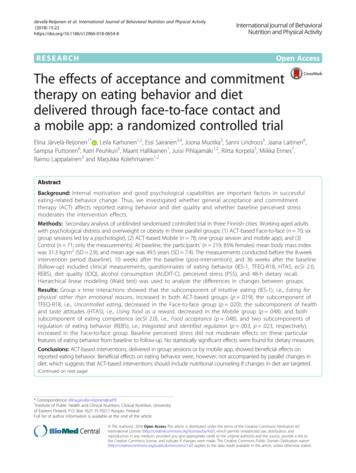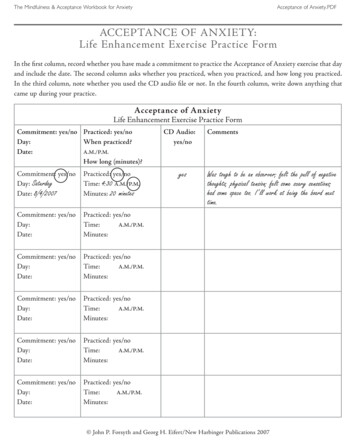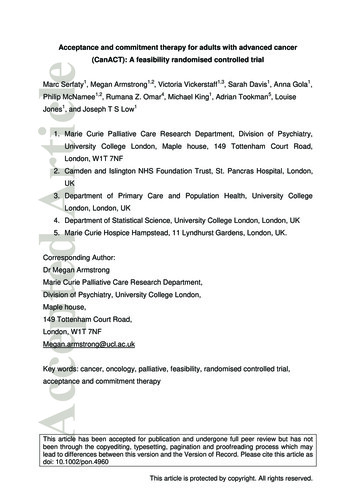
Transcription
Acceptance and commitment therapy for adults with advanced cancer(CanACT): A feasibility randomised controlled trialMarc Serfaty1, Megan Armstrong1,2, Victoria Vickerstaff1,3, Sarah Davis1, Anna Gola1,Philip McNamee1,2, Rumana Z. Omar4, Michael King1, Adrian Tookman5, LouiseJones1, and Joseph T S Low11. Marie Curie Palliative Care Research Department, Division of Psychiatry,University College London, Maple house, 149 Tottenham Court Road,London, W1T 7NF2. Camden and Islington NHS Foundation Trust, St. Pancras Hospital, London,UK3. Department of Primary Care and Population Health, University CollegeLondon, London, UK4. Department of Statistical Science, University College London, London, UK5. Marie Curie Hospice Hampstead, 11 Lyndhurst Gardens, London, UK.Corresponding Author:Dr Megan ArmstrongMarie Curie Palliative Care Research Department,Division of Psychiatry, University College London,Maple house,149 Tottenham Court Road,London, W1T 7NFMegan.armstrong@ucl.ac.ukKey words: cancer, oncology, palliative, feasibility, randomised controlled trial,acceptance and commitment therapyThis article has been accepted for publication and undergone full peer review but has notbeen through the copyediting, typesetting, pagination and proofreading process which maylead to differences between this version and the Version of Record. Please cite this article asdoi: 10.1002/pon.4960This article is protected by copyright. All rights reserved.
Objective: To understand the feasibility of recruiting people with advanced cancerinto a randomised controlled trial of Acceptance and Commitment therapy (ACT) vsa standardised Talking Control (TC) and delivering ACT to this population; to explorethe acceptability of outcome measures and generate normative data.Methods: This was a feasibility two-arm randomised controlled trial. Participantswere attendees with advanced cancer at one of three hospice-based day- therapyunits in London, UK, who demonstrated low scores on the Functional Assessment ofCancer Therapies – General (FACT-G). The primary end point was three months.Results: The recruitment target was 54 participants; 42 people were recruited andrandomised to up to eight individual sessions of ACT (n 20) or TC (n 22). 18/42(43%) of participants completed the primary outcome at three months, and at leastone follow-up was available in 30/42 (71%) participants. An exploratory analysisrevealed a non-significant adjusted mean difference after three months in the mainoutcome FACT-G of -3.41 (CI -18.61, 11.79) with TC having better functioning.Over six months the adjusted mean difference between trial arms was 2.25 (CI 6.03, 10.52) in favour of ACT.Conclusions: It is feasible to recruit people with advanced cancer in a trial of ACTversus TC. Future research should test the effectiveness of ACT in a fully poweredtrial.Trial Registration: ISRCTN13841211 (registered 22 July 2015)This article is protected by copyright. All rights reserved.
In the UK, the National Institute for Clinical and Care Excellence recommends thatpeople with advanced illnesses should have their psychological needs met1.Acceptance and Commitment Therapy (ACT) has shown promise in a range ofpopulations2. ACT involves key processes that include helping people to worktowards doing what is important to them (values) through building up resilience touncomfortable experiences such as thoughts and feelings (acceptance)2. Increasedacceptance is associated with decreased psychological suffering3 and facilitatesengagement with life despite limitations imposed by illness4.Whilst ACT may be beneficial for a range of psychological disorders, studies in lifethreatening illnesses are limited5; only one trial has been identified for people withadvanced (ovarian) cancer6, which suggested that ACT, compared tocognitivebehavioural therapy type intervention, was associated with improved quality of lifeand decreased psychological distress6.Our study is based on previous work, which found an association betweenacceptance, psychological and physical function in hospice day-therapy attendees(i.e., those receiving palliative care);this work supported the rationale for an ACTbased intervention for improving outcomes for those with palliative care needs7. Asnon-specific effects of therapy, such as therapist warmth, may contribute toimprovement, a ‘Talking Control’ (TC) was used as a comparison8. A TC alsofacilitates engagement, by minimising attrition through offering an intervention9.This paper presents a feasibility randomised controlled trial comparing ACT with aTC (CanACT) for hospice attendees with impaired function. The aims were to test: (i)the feasibility and acceptability of delivering ACT in people with advanced cancer; (ii)the feasibility of conducting an RCT of ACT versus TC in this population; (iii) theacceptability of a range of outcome measures; and (iv) whether outcomes on theFACT-G were consistent with potential change with treatment.METHODDesignThis article is protected by copyright. All rights reserved.
A feasibility, parallel group, two-armed, randomised controlled trial of ACT versusTC.Study populationWe aimed to recruit 54 participants based on pragmatic grounds to demonstratefeasibility in terms of recruitment, acceptance of randomisation, and likely attritionwithout the need for a power calculation.10 People with advanced cancer attendingday-therapy services, as in or out-patients, at three hospices in London, UK wereconsidered for participation if they were aged 18 years or more with a diagnosis ofadvanced cancer not amenable to cure (i.e., metastases at first diagnosis,subsequent recurrence, or lung cancer with or without metastases). People wereexcluded if they had a clinician-estimated survival of less than four months, aninsufficient command of English to engage in a talking therapy, cognitive impairment,or were currently receiving CBT or ACT: please see protocol11. Potential participantswere screened using the FACT-G (lower scores indicating lower functioning)7. Themean FACT-G score in a cancer population is 80.9 (SD 17.0)12. Therefore, athreshold of below 81 for entry into the trial was selected.Interventions, training and supervisionParticipants were offered eight, weekly sessions of either ACT or TC that lasted upto an hour, and were adapted for use in advanced cancer. The sessions weredelivered by one of six therapists over a period of up to three months, face-to-face inthe hospice day-therapy unit, the participant’s home or the therapist’s clinic.Participants were given three months to complete their eight therapy session to allowfor missed sessions due to reasons such as illness.Therapists who delivered ACT also delivered TC to control for non-specific therapyfactors. All therapists had at least two years’ experience of using ACT and receivedtwo full days’ training on ACT and TC in a palliative care population from the chiefinvestigator (MS) and an experienced ACT therapist (MW); both were extensivelytrained in ACT. The training was supplemented with two half-day booster sessionsduring the study. There was fortnightly supervision from MS and MW, which wasThis article is protected by copyright. All rights reserved.
also attended by a research nurse (SD) who provided support about working with apalliative care population.The six therapists in this study were paid at sessional rates. Three out of sixtherapists already worked in cancer clinics and used ACT. All therapists took part inthis study to improve their skills in ACT and to apply it to an advanced cancerpopulation. We ensured at least one experienced therapist was based at each of thethree hospices.ACT sessions and manualThe first four sessions of therapy aimed at helping the participant understand theconcept of ACT and the psychopathological elements (e.g., experiential avoidance,cognitive fusion) and ACT interventions (e.g. increasing acceptance, defusiontechniques). Once these components had been covered, the last sessions aimed athelping the participant practice these in order to become more psychologicallyflexible. Further details of the therapy sessions can be found in supplementarymaterial 1.The ACT manual, available on request, was a bespoke piece of work prepared byMS and MW targeting therapists with existing knowledge of ACT. It was informed byprevious experts in ACT2,4 and adapted so ACT may be applied to people withadvanced cancer. This manual was a guide for the therapists to use. It was stressedthat strict adherence to the manual would be rigid and inconsistent with the need tomodel a psychologically flexible approach. The manual comprised three sections: (1)background of ACT and use in advanced cancer; (2) the content of ACT and (3)materials for use in ACT.Talking Control sessions and manualThe TC involves a conversation led by the participant. The therapist gains theparticipants’ interest and trust by being empathic and allowing them to feel heard,without commenting on the content of the material presented. It purposefully doesnot encourage exposure or avoidance of feared situations, it does not seek toproblem solve, challenge beliefs, use mindfulness techniques or explore differentThis article is protected by copyright. All rights reserved.
ways of behaving. Although there are some similarities to befriending, the TC isundertaken by the same therapist who also delivers the specified intervention, in thiscase ACT, but no lay equivalent of lay advice is given.The TC manual was developed specifically for the project and is broadly based onthe non-specific side effects of psychotherapy. The manual was based on previousresearch using a TC.8 The TC manual provided examples and case studies of how tobe empathic whilst remaining neutral and not offering advice.ProcedureDuring November 2015 to 2016, day-therapy staff identified potential participantsusing the inclusion/exclusion criteria and sought verbal consent for researchers(MA/PM) to approach them about the study. Researchers then explained theCanACT study and asked them to complete the FACT-G. Researchers invited thosewith a FACT-G score below 81 to participate, and gave them written informationabout the study. Those who agreed to participate gave written informed consent tothe researchers and completed baseline assessments. A researcher (MA/PM)allocated each participant to the next available therapist. Randomisation then tookplace and a senior researcher (JL) gave the allocated therapist information about theparticipant’s group allocation and their contact details. Researchers (MA/PM), whowere blinded, undertook follow-up assessments over the phone or face-to-face in alocation of the participant’s choice.RandomisationParticipants were randomised by a senior researcher (JL) to either ACT or TC usingan independent web-based randomisation system (Sealed Envelope)Ethics approvalRiverside Research Ethics Committee (ref 14/LO/0813) approved the study on 4 thJuly 2014.OutcomesI. Feasibility of recruitment and retention: The recruitment target was 54 participants over 12-months.This article is protected by copyright. All rights reserved.
Retention of at least 60% of participants (i.e., until the main follow-up timepoint of three months).13 Rates of and reasons for attrition. The capacity to collect data from participants and hospice records.II. Attitudes to and engagement with therapy, and acceptability of outcome measures Acceptable feasibility criterion, adapted from previous research13, whereby60% of participants were expected to engage at least “mostly with therapy”,according to the following criteria:o Non-engagement: attended 0/8 sessionso Somewhat engaged: attended 1-4/8 sessionso Mostly engaged: attended 5-6/8 sessionso Fully engaged: attended 7-8/8 sessions Treatment preference was assessed at baseline using two questions: “howmuch would you hope to receive ACT?” and “how much would you hope toreceive TC?”14. Scores ranged from 0 (Not at all) to 3 (Completely) for eachitem with higher scores indicting a preference for ACT or TC. Participants were asked to rate their expectation of ACT at baseline byrecording on a scale of 1 (Not at all) to 10 (Completely) for how much theyexpected to change 15. Satisfaction with therapy after three months was measured using a shortenedversion of the Counselling Questionnaire 16.The amount of missing data was used as one indication of the acceptability ofthe outcome measures.III. Quantitative measuresDemographicsAt baseline, age, gender, ethnicity, marital status, education level, previouspsychiatric history, type of cancer, date of diagnosis, and the employment status ofthe main salaried person in the household were recorded.FunctioningThis article is protected by copyright. All rights reserved.
The primary outcome was the Functional Assessment of Cancer Therapies –General (FACT-G) (Version 4). It was selected as it has widely been used in peoplewith advanced cancer and focuses on more than one aspect of pathology 17. Itcomprises 27 items in four domains: physical well-being; social/family well-being;emotional well-being; and functional well-being. Each item is rated 0-4. The totalscore ranges from 0 to 108. A lower score indicates poorer functioning.Psychological distressThe Kessler Psychological Distress Scale (K10) 18, a validated 10 item scale;7, ratingeach item 1-5, total score 10 to 50, with 20 indicating psychological distress.Physical functioningTwo tests of physical functioning were used 19: A two minute walking test – the distance in metres that participants were ableto walk in two minutes. A one minute sit-to-stand test – the numbers of times participants were able tostand up from a chair without using their arms in a minute.Acceptance Commitment Therapy process(i)AcceptanceThe Acceptance and Action Questionnaire II (AAQII):20 A validated 10 item measure,used in the preliminary study7to assess experiential avoidance and psychologicalinflexibility. Each item is scored from 1 to 7, total range of 10-70, where higherscores indicate greater psychological inflexibility.(ii)Living according to one’s valuesThe Valued Living Questionnaire (VLQ)21, a validated 20 item scale evaluating theconsistency of people’s actions with their values. Each item is rated 1-10. Higherscores indicate living consistently with one’s values.Economic(i)The EQ-5D-5L22: a validated quality of life (QoL) measure. A visual analoguescale (0-100) rates current health status. Higher scores indicate a better QoL.This article is protected by copyright. All rights reserved.
(ii)The short modified version of the Client Services Receipt Inventory (CSRI)23collects participants’ use of health services in the preceding three months.Sources of biasAssessment of blindnessNeither participants nor therapists were blind to treatment allocation. To assess theblindness of the researchers (MA/PM), each attempted to guess the participant’streatment group at the three and six months’ assessment.Other treatments usedFrom medical notes and participants’ self-report we recorded:(i)Prescribed medications.(ii)Other psychological therapies offered as part of treatment as usual.(iii)Use of gym and physical therapies.Timing of measuresAll measures were collected at three time-points: at baseline, three months (postintervention), and six months. Additionally, the FACT-G was collected at six weeksand 18 weeks post baseline. Responses were accepted that were within /- 3.25weeks (23 days) of the due date 3.25 weeks was chosen as this was the mid-pointbetween the follow-ups.Data analysisOur main analysis focused on recruitment, engagement with therapies and attritionfrom the research process. Summary measures are presented for the baselinecharacteristics of each trial arm as mean and standard deviation for continuousvariables, and frequencies and percentages for categorical variables. We basedthese summaries on observed observations only.This article is protected by copyright. All rights reserved.
In an exploratory analysis, we estimated differences (with confidence intervals) in themain outcomes between the trial arms at three months. A linear regression adjustedfor baseline values of the outcome and the stratification factor (centre) was used.The normality assumptions of the residuals were investigated using residual plots.We also used a mixed effect model, using all patient data over the 6-months, toinvestigate the effect over time. Such models allow analysis of repeated outcomemeasurement data whilst taking into account the correlation between measurementsfrom the same patient. All analyses were carried out as allocated and based oncomplete cases using the statistical software STATA Version 14.RESULTSCharacteristics of the participantsOver 12-months, 42 out of a target of 54 participants (78%) were recruited into thestudy (Figure 1). Forty-two people were randomised; 22 to TC and 20 to ACT. Due toan administration error, one participant allocated to TC received ACT. Data from thisparticipant was analysed as part of the TC group according to the protocol. Thesample was predominately female (31/42; 74%), white (34/42; 81%), educated to adiploma level or higher (28/42; 67%) with a mean age of 62 years (SD 11.5) and themost common diagnosis was breast cancer (20/42; 48%) (Table 1). Thecharacteristics of participants in both arms were similar except in the ACT arm wherethere were fewer people educated to diploma level (i.e., completed two or moreyears at degree level or similar) and above.FeasibilityRecruitmentWe recruited 78% (42/54) of the target. The main barriers to achieving therecruitment target were limited availability of therapists, all eligible participantsalready taking part in the study and restriction of the sample to those with advancedcancer.Follow upData from 18/42 (43%) were available at three months (the primary end point), whichmissed our aim of 60% retention. Data from at least one follow-up were available inThis article is protected by copyright. All rights reserved.
30 out of 42 (71%) participants. Reasons for attrition included death, deterioratinghealth, and loss to follow-up (see Figure 1). One person felt the therapy wasunsuitable. At the primary time point (three months) there was no statisticaldifference in attrition between the arms.Collecting participants’ dataCollecting data on medication was limited as hospice notes were not easilyaccessible and omitted medication prescribed by general practitioners.AcceptabilityUptake of therapy sessions26/42 (62%) mostly or fully engaged with therapy by attending 7 or more therapysessions: (11/21 (52%) ACT participants and 15/21 (71%) TC participants), whichmet our aim of at least 60% engaged in therapy Six (14%) participants received notherapy (five in ACT and one in TC). Reasons for non-attendance included: suddendeterioration in health (one death, two hospital admissions), two felt therapy“involved too much commitment” and one gave no reason. Of those 36 participantswho attended at least one therapy session, 69% (11/16) mostly or fully engaged withtherapy in ACT and 75% (15/20) in TC.Satisfaction with therapyOf those followed up at three months, 5/6 (83%) ACT participants and 5/10 (50%)TC participants found the therapy useful and 6/6 (100%) ACT and 6/10 (60%) TCparticipants found talking to the therapists easy. (See Supplementary material 2).Treatment preferenceThe treatment preference was a mean of 1.6 (SD 1.2) for ACT and 1.3 (SD 1.2) forTC, indicating no strong preference for receiving either ACT or TC at baseline.Expectation of ACTParticipants’ expectancy of improving was a mean of 5.9 (SD 2.5) for ACT and 5.6(SD 2.5) for TC.This article is protected by copyright. All rights reserved.
Acceptability of measuresFor the participants who provided follow-up data at three months, there were nomissing items for the Kessler 10, EQ-5D-5L and CSRI. On the FACT-G, twoparticipants (11%) had missing items (2 and 6 items respectively), one person (6%)had one missing item on the AAQ-II and six (38%) participants had at least onemissing item on the VLQ (range 1-8 missing items). At three months, 12 out of 18participants did not complete the physical function test, the main reasons beingphysical limitations, lack of time, or recent activity in the hospice gym.Participant reported outcomesFunctioning (Table 2 and Figure 2)At three months, there was an adjusted mean difference of -3.41 (95% CI -18.61,11.79) in FACT-G scores between the TC and ACT groups, with TC having higherscores. The FACT-G subscales at three months showed mean differences in favourof TC for physical, emotional and functional wellbeing and in favour of ACT forsocial/family wellbeing. Over six months, the adjusted mean difference in total FACTG scores was 2.25 (95% CI -6.03, 10.52) in favour of ACT.Psychological distressPsychological distress, measured using the Kessler 10, showed that at baseline,there was mild distress in both the ACT (mean 26.3; SD 7) and TC (mean 23.2;SD 7.9) groups. At three months, psychological distress was mild for those in theACT (mean 22.1; SD 7.9) group and absent for those in the TC (mean 18.3;SD 4.9) group. The adjusted mean difference at three months was 0.6 (CI -7.25,8.53). (See Table 2 for all secondary outcomes).Physical functioningWalking test: the mean at baseline was 78.6 metres (SD 15.5, N 7) and 67.5(SD 23.3, N 2) at three months for those receiving ACT and 79.8 (SD 24.9, N 9) atbaseline and 107 (SD 65.5, N 5) at three months for TC.Sit-to-stand test: the mean at baseline was 11.7 (SD 3.1, N 7) and at three monthswas 20.5 (SD 3.5, N 2) for ACT. In TC, the mean was 17.4 (SD 8.7, N 9) atThis article is protected by copyright. All rights reserved.
baseline and 10.6 (SD 6.4, N 5) at three months. Due to the level of attrition forboth physical functioning tests, mean differences at three months were notcalculated.Process of ACTIn the ACT arm, the mean score on the AAQ-II was 34.1 (SD 10.2) at baseline and31.1 (SD 8.0) at three months. In the TC arm, the score was 31.5 (SD 9.8) atbaseline and at three months was also 30.0 (SD 5.6).For the Valued Living Questionnaire, the adjusted mean difference between ACTand TC was 0.22 (95% CI -19.42, 19.87) at three months.EconomicFor the EQ-5D-5L, the adjusted mean difference at three months between ACT andTC was -0.01 (95% CI -0.14, 0.13); for EQ-VAS it was -5.45 (95% CI -18.61,11.79). The modified CSRI showed a mean difference of 3.28 (95% CI -14.76,18.61) between ACT and TC at three months.The total cost of the intervention, which included provision of both therapies,mentoring and training over the study duration, was 22,970.For patients who received ACT, total costs associated with therapy provision were 7,820 while costs associated with training and mentoring were 2,180 and 765respectively. The cost per participant was 538.25.For TC, the total cost of providing therapy was 10,030, while training and mentoringcosts were 1,920 and 255 respectively. The cost per participant was 554.77,which is slightly higher than ACT due to the higher session uptake (26 sessionsmore than ACT). This cost is hypothetical, however, as were a talking treatment ofthis nature scaled up, it would not be delivered by such a skilled or costly therapist.Sources of biasAssessment of blindnessThis article is protected by copyright. All rights reserved.
The researchers correctly guessed the participants’ group allocation on 65% (11/17)of occasions at three months and 73% (11/15) of the time at six months.Thissuggests some degree of un-blinding at three months.Other treatments usedAt three months in the ACT group, 4/7 (57%) participants had received psychologicaltherapy, 4/7 (57%) complementary therapy, and 4/7 (57%) attended the gym. In TC,1/11 (10%) received psychological therapies, 7/11 (70%) received complementarytherapies, and 6/11 (60%) attended the gym.CONCLUSIONSIt is feasible to recruit people with advanced cancer into a trial of ACT versus TC.Participants engaged well with therapy; of those who attended at least one session,10/16 (63%) went on to be fully engaged in ACT (i.e., attend 7-8 sessions).Moreover, participants reported satisfaction with the intervention they received.However, completion of the main outcome at the primary endpoint (3 months) waslow. This finding suggests that participants from a palliative care population foundACT highly acceptable, but researchers should focus on reducing the burden ofresearch and therefore increasing the feasibility of this research.The main strength of this study was the high engagement of participants in thetherapy sessions. Furthermore, recruitment was acceptable, possibly becauseinterventions were offered to all participants. To increase recruitment rates, wesuggest broadening the target population to include people receiving palliative carefor all diagnoses. As ACT does not aim to restore full function, but rather helpspeople cope with dysfunction, it may offer promise to people with chronic, lifethreatening physical disease. Although participants engaged well with therapy, theircompletion of the FACT-G was inconsistent, largely because of ill health at the timeof data collection. We have therefore been cautious not to interpret or extrapolatethese findings for comparison with other studies.Study limitationsThis article is protected by copyright. All rights reserved.
A weakness of this study was participants often declined to complete the follow-upassessments. High attrition is a common issue in palliative care24 and futureresearch should focus on ways to increase retention. Twelve per cent of participantsdied during their first three months in the trial. Whilst theoretically retention could beenhanced by recruiting people with a better estimated prognosis, in reality cliniciansare poor at predicting outcome25. We suggest it may be more beneficial to limit thenumber of outcome measures and follow-up time points in a future trial based on theparticipant feedback received. In particular, the physical outcome measures wereunacceptable for this population and could be omitted. Whereas, a main outcomemeasure like the FACT-G provides an acceptable measure of functioning in severaldomains in this population. More flexibility around the timing of follow-ups wouldallow for the challenges raised by the unpredictable course of advanced illnesses.This study used a TC to control for non-specific therapy factors. Future researchshould test the effectiveness of ACT against treatment as usual. Furthermore, wecollected data at baseline on participants’ expectation of change were they to receiveACT; in hindsight, to allow comparison of both groups, participants’ expectations withTC should also have been recorded. Lastly, we aimed to rate the fidelity of thetherapy sessions but due to cost constraints this was not possible.Clinical and research implicationsOur two measures of ACT processes suggested that compared to a normalpopulation, the sample had higher levels of experiential avoidance, psychologicalinflexibility and were less able to act in accordance with what is important to them(values),20,21 which is consistent with the rationale for using ACT in a palliativepopulation. Psychotherapies can only be beneficial if participants choose to engagewith them26. The CanACT trial has demonstrated that ACT is an acceptablepsychotherapy, demonstrated by a high attendance of therapy sessions, for peoplewith advanced cancer. Reducing the number of outcome measures and researchburden on participants may limit attrition. The next stage of this research is to testthe clinical and cost effectiveness of ACT in a palliative population in a larger trial.This article is protected by copyright. All rights reserved.
REFERENCES1.Part A, Gysels M, Higginson IJ. Improving supportive and palliative care for adultswith cancer. 2002.2.Hayes SC, Strosahl KD, Wilson KG. Acceptance and commitment therapy: Anexperiential approach to behavior change: Guilford Press; 1999.3.Hall PS, Edlin R, Kharroubi S, Gregory W, McCabe C. Expected net present value ofsample information: from burden to investment. Medical Decision Making. 2012;32(3):E11E21.4.Hayes SC, Luoma JB, Bond FW, Masuda A, Lillis J. Acceptance and commitmenttherapy: Model, processes and outcomes. Behaviour research and therapy. 2006;44(1):1-25.5.Öst L-G. The efficacy of Acceptance and Commitment Therapy: an updatedsystematic review and meta-analysis. Behaviour research and therapy. 2014;61:105-21.6.Rost AD, Wilson K, Buchanan E, Hildebrandt MJ, Mutch D. Improving psychologicaladjustment among late-stage ovarian cancer patients: Examining the role of avoidance intreatment. Cognitive and Behavioral Practice. 2012;19(4):508-17.7.Low J, Davis S, Drake R, King M, Tookman A, Turner K, et al. The role ofacceptance in rehabilitation in life-threatening illness. Journal of Pain and SymptomManagement. 2012;43(1):20-8.8.Serfaty M, Csipke E, Haworth D, Murad S, King M. A talking control for use inevaluating the effectiveness of cognitive-behavioral therapy. Behaviour research andtherapy. 2011;49(8):433-40.9.Stevens SE, Hynan MT, Allen M. A Meta‐Analysis of Common Factor and SpecificTreatment Effects Across the Outcome Domains of the Phase Model of Psychotherapy.Clinical Psychology: Science and Practice. 2000;7(3):273-90.10.Billingham SA, Whitehead AL, Julious SA. An audit of sample sizes for pilot andfeasibility trials being undertaken in the United Kingdom registered in the United KingdomClinical Research Network database. BMC medical research methodology. 2013;13(1):104.11.Low J, Serfaty M, Davis S, Vickerstaff V, Gola A, Omar RZ, et al. Acceptance andcommitment therapy for adults with advanced cancer (CanACT): study protocol for afeasibility randomised controlled trial. Trials. 2016;17(1):77.12.Brucker PS, Yost K, Cashy J, Webster K, Cella D. General population and cancerpatient norms for the Functional Assessment of Cancer Therapy-General (FACT-G).Eval
Acceptance and Commitment Therapy (ACT) has shown promise in a range of populations2. ACT involves key processes that include helping people to work towards doing what is important to them (values) through building up resilience to uncomfortable experiences such as thoughts and feelings (acceptance)2. Increased
